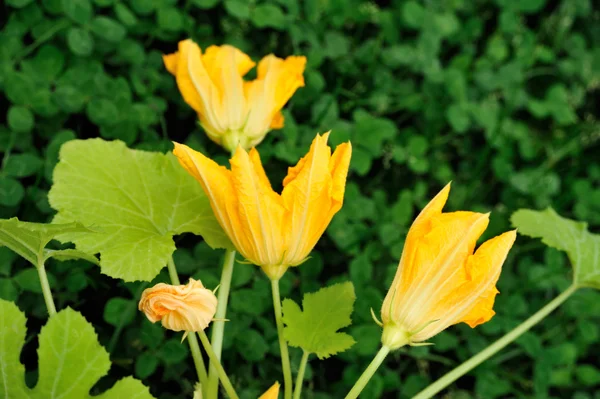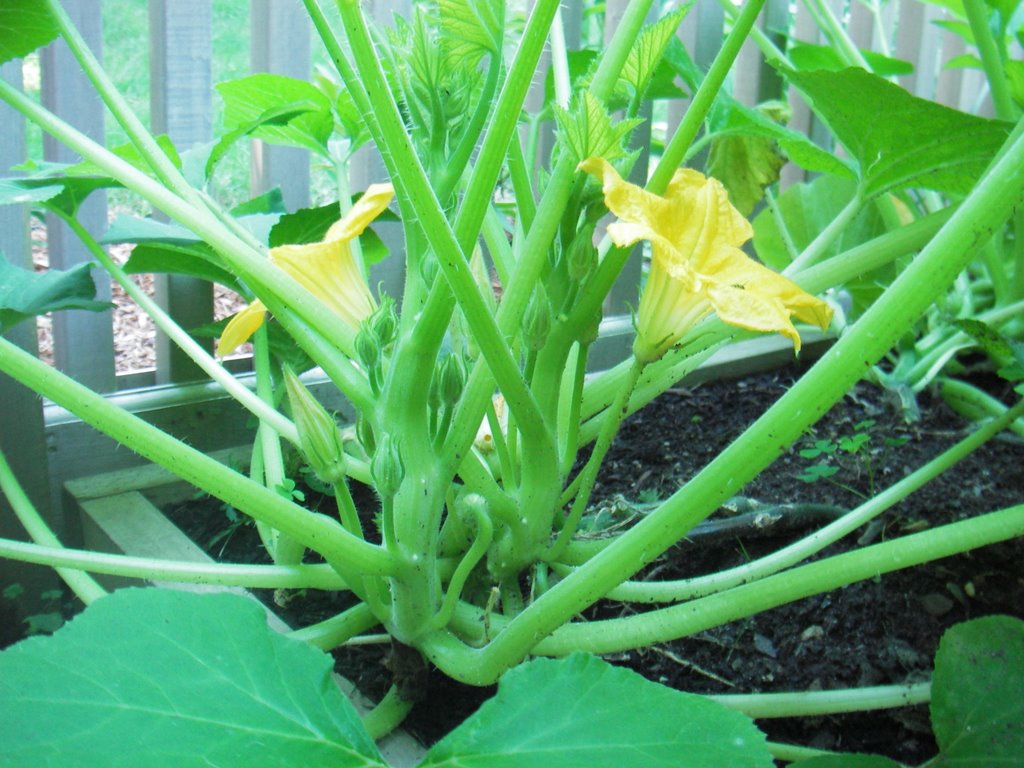Squash Flowers
Zucchini and Summer Squash Recipes. Famously prolific summer squash plants bring plenty of zucchini, yellow crookneck, and pattypan squash into our lives at this time of year. The mild- tasting, versatile vegetable (okay, technically a fruit) is equally delicious in savory and sweet dishes. In Season: Summer squash are in season during the summer, peaking at the end.
What to Look For: Look for summer squash that are firm and heavy for their size; the skin should be brightly colored and blemish- free. Because they are harvested earlier, smaller squash are more tender than larger ones and have thinner skins; choose squash that are less than eight inches long. How to Store: Refrigerate in a plastic bag for up to four days; do not wash until ready to use.
Zucchini - Wikipedia. Zucchini (, American English) or courgette (, British English) is a summer squash which can reach nearly a metre in length, but is usually harvested immature at 1. In Britain and Ireland a fully grown zucchini is referred to as a marrow. Along with certain other squashes and pumpkins, it belongs to the species Cucurbita pepo. Zucchini can be dark or light green. A related hybrid, the golden zucchini, is a deep yellow or orange color.[2]In a culinary context, zucchini is treated as a vegetable; it is usually cooked and presented as a savory dish or accompaniment. Botanically, zucchinis are fruits, a type of botanical berry called a "pepo", being the swollen ovary of the zucchini flower.
Cucurbita (Latin for gourd) is a genus of herbaceous vines in the gourd family, Cucurbitaceae, also known as cucurbits, native to the Andes and Mesoamerica.
Zucchini, like all squash, has its ancestry in the Americas. However, the varieties of squash typically called "zucchini" were developed in northern Italy in the second half of the 1. Americas in the early 1.
Harvest- ready, though not yet full- grown zucchini on plant; the glossy skin is progressively lost after the first week following anthesis. How To Make A Special Coffee. Golden zucchini produced in the Netherlands for sale in a supermarket in Montpellier, France in April 2.
In the United States, Australia and Germany, the plant is commonly called a zucchini ( ( listen); plural: zucchini or zucchinis), from Italian: zucchina[3][dzukˈkiːna][4] (plural: zucchine), diminutive of zucca, "gourd, marrow, pumpkin, squash". The name courgette (French pronunciation: [kuʁ.ʒɛt]) is a French loan word, the diminutive of courge, "gourd, marrow", and is commonly used in France, Belgium and other Francophone areas, and in the United Kingdom, Ireland, New Zealand, Scandinavia, the Netherlands and South Africa. In the United Kingdom, Ireland and New Zealand, a fully- grown, matured courgette is referred to as a marrow.[5] Most marrow cultivars sold in the UK are striped.[citation needed] In South Africa, the fruit is typically harvested as a baby vegetable, approximately finger size, and is referred to as “baby marrows”.[6][7]The female flower is a golden blossom on the end of each emergent zucchini.
The male flower grows directly on the stem of the zucchini plant in the leaf axils (where leaf petiole meets stem), on a long stalk, and is slightly smaller than the female. Both flowers are edible and are often used to dress a meal or to garnish the cooked fruit. Firm and fresh blossoms that are only slightly open are cooked to be eaten, with pistils removed from female flowers, and stamens removed from male flowers.
The stems on the flowers can be retained as a way of giving the cook something to hold onto during cooking, rather than injuring the delicate petals, or they can be removed prior to cooking, or prior to serving. There are a variety of recipes in which the flowers may be deep fried as fritters or tempura (after dipping in a light tempura batter), stuffed, sautéed, baked, or used in soups. History and etymology[edit]Zucchini, like all squash, has its ancestry in the Americas. However, the varieties of green, cylindrical squash harvested immature and typically called "zucchini" were developed in northern Italy, long after the introduction of cucurbits from the Americas. It appears that this occurred in the second half of the 1. Milan in 1. 90. 1; [8] early varieties usually appended the names of nearby cities in their names. The word zucchini and this culinary variety of C. Daisy Martinez.
Burpee's squash seeds grow in any home garden. Shop our zucchini, butternut, scallop, winter and summer squash at Burpee Seeds. Burpee.

Tuscany and northern Italy.[9]Zucca is the Italian word for pumpkin/squash and zucchino/zucchina (zucca + ina = little) are diminutive forms, becoming zucchini/zucchine in the plural. Zucchino, the masculine form (zucchini in the plural), is the first form to be documented in writing.[3] An Italian dictionary called lo Zingarelli 2. Zanichelli Editore, gives both forms, as does the Devoto- Oli published by Le Monnier, but the Accademia della Crusca, the most important research institution on Italian language, defines zucchino as the preferable form.[3] The Treccani, Istituto dell'Enciclopedia italiana, another highly respected linguistic authority, gives zucchina as the main Italian word, and the masculine form as Tuscan dialect. Zucchini is used in Italy, Australia, Canada, Sweden and the United States. Zucchini is one of the plural forms in English (along with zucchinis), as well as the singular form.[1. The first records of zucchini in the United States date to the early 1. It was almost certainly brought to America by Italian immigrants and probably was first cultivated in the United States in California.
Indiana Yard and Garden – Purdue Consumer Horticulture - A Purdue Extension Service for Home Gardeners - Purdue University, West Lafayette, Indiana. Identification of Male and Female Flowers: Assuming all has gone well, sometime in July, your pumpkin plant will begin to produce flowers.
A 1. 92. 8 report on vegetables grown in New York State treats 'Zucchini' as one among 6. C. pepo.[1. 1]Culinary uses[edit]When used for food, zucchini are usually picked when under 2. Mature zucchini can be a metre long or more. The larger ones are often fibrous.

A zucchini with the flowers attached is a sign of a truly fresh and immature fruit, and it is especially sought after for its sweeter flavor.[1. Unlike cucumber, zucchini is usually served cooked. It can be prepared using a variety of cooking techniques, including steamed, boiled, grilled, stuffed and baked, barbecued, fried, or incorporated in other recipes such as soufflés.
Zucchini can also be baked into a bread[1. Its flowers can be eaten stuffed and are a delicacy when deep fried, as tempura. Zucchini has a delicate flavor and requires little more than quick cooking with butter or olive oil, with or without fresh herbs.[1. The skin is left in place. Quick cooking of barely wet zucchini in oil or butter allows the fruit to partially boil and steam, with the juices concentrated in the final moments of frying when the water has gone, prior to serving. Zucchini can also be eaten raw, sliced or shredded, in a cold salad, as well as lightly cooked in hot salads, as in Thai or Vietnamese recipes.
Mature (larger sized) zucchini are well suited for cooking in breads. Zucchinis can be cut with a spiralizer to make zucchini noodles for low- carbohydrate recipes. In Bulgaria, zucchini may be fried and then served with a dip, made from yogurt, garlic, and dill.
Another popular dish is oven- baked zucchini—sliced or grated—covered with a mixture of eggs, yogurt, flour, and dill. In Egypt, zucchini may be cooked with tomato sauce, garlic, and onions.[1. In France, zucchini is a key ingredient in ratatouille, a stew of summer fruits and vegetables prepared in olive oil and cooked for an extended time over low heat. The dish, originating near present- day Nice, is served as a side dish or on its own at lunch with bread. Zucchini may be stuffed with meat or with other fruits such as tomatoes or bell peppers in a dish called courgette farcie (stuffed zucchini).
In Greece, zucchini is usually fried or stewed with other fruits (often green chili peppers and eggplants). It is served as an hors d'œuvre or as a main dish, especially during fasting seasons. Zucchini is also stuffed with minced meat, rice, and herbs and served with avgolemono sauce. In several parts of Greece, the flowers of the plant are stuffed with white cheese, usually feta or mizithra cheese, or with a mixture of rice, herbs, and occasionally minced meat. They are then deep- fried or baked in the oven with tomato sauce.
In Italy, zucchini is served in a variety of ways: fried, baked, boiled, or deep fried, alone or in combination with other ingredients. At home and in some restaurants, it is possible to eat the flowers, as well, deep- fried, known as fiori di zucca. Pumpkin flower fritter)In Levantine countries such as Palestine, Jordan, and Lebanon, zucchini is stuffed with minced meat and rice plus herbs and spices. The dish, called محشي (mahshi), is then boiled in tomato based sauce, commonly cooked with ورق دوالي (warak dwali; stuffed grape leaves). It is served with yogurt or laban.
Zucchini is also used in various kinds of stew. Stews that have low salinity are favorable in such cooking. In Mexico, the flower (known as flor de calabaza) is often cooked in soups or used as a filling for quesadillas. The fruit is used in stews, soups (i.
